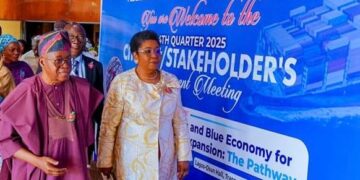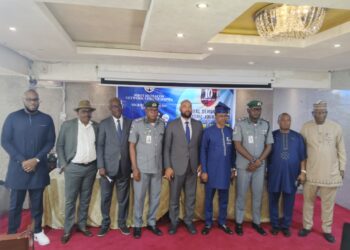The Federal Government Port Concession programme began in 2005/2006 with agreements entered into by and between the Bureau Of Public Enterprises (BPE) as confirming party for the Lessor and mid-wife of the entire
scheme, the Nigerian Ports Authority (NPA) as the Lessor and Terminal Operators as the Lessee.
scheme, the Nigerian Ports Authority (NPA) as the Lessor and Terminal Operators as the Lessee.
These agreements were duly executed by respective parties indicating that all parties to the agreement know exactly what obligations are imposed on them.
It therefore gladdens my heart to note that the theme of this conference is monitoring and compliance. Consequently, I urge the participants and stakeholders to take advantage of information that would be put to their
disposal.
disposal.
In the last eight (8) years of port concession, a lot of positive changes and developments have taken place in all our ports, as highlighted below:
INFRASTRUCTURE
v
Rehabilitation and Reconstruction of quay aprons and stacking areas
Rehabilitation and Reconstruction of quay aprons and stacking areas
v Expansion and Reconstruction of container terminals
v Rehabilitation of terminal access roads
v Provision of lightening facilities including generating sets
v Rehabilitation of the sheds/warehouses
v Reconstruction of Drainages
v Construction of Perimeter Fencing and Gate Houses
v Improved workshop facilities of modern standards
PLANTS AND EQUIPMENT
v Acquisition of modern state of art forklifts
v Acquisition of container handlers for cellular trade demand
such as Gantry cranes, Reach stackers, Handlers Mafi- tugs etc.
such as Gantry cranes, Reach stackers, Handlers Mafi- tugs etc.
STEVEDORE SERVICES AND DOCK LABOUR REFORMS
v
Stream-lining stevedoring companies
Stream-lining stevedoring companies
v Establishment of an acceptable manning scale to ensure high productivity
v Application of direct interview selection and employment of dock labours with joint effort of stevedoring contractors under the supervision of NIMASA
v Elimination of zoning and permanent berth ownership by dock labours
v Improved salary structure and better welfare packages
v Training and re-training as well as capacity building opportunities
The applications of these strategies have resulted in the
following;
following;
v Continuous ship discharge/loading operation within the working time without erratic stoppage of ship operations.
v Strict monitoring of allocated labour to achieve projected productivity
v Achievement of high level of discipline and control of extortion
v Eradication o pilferages and reduction of damages to cargoes and properties as a result of effective safety and security management
v Improved turn-around time of vessels, consequently, increased productivity
v Elimination of under declaration of cargoes, leading to more revenue generation for the government , due to draft survey exercise and effective documentation
SECURITY
In addressing the security challenges of the ports, the concessionaires apart from constructing standardized perimeter fencing, made the following provisions;-
·
A well trained security outfit, that is compliant with the (NIMASA) certification in compliance to ISPS Code
A well trained security outfit, that is compliant with the (NIMASA) certification in compliance to ISPS Code
·
Installation of Security gadgets such as CCTV, and improved communication system
Installation of Security gadgets such as CCTV, and improved communication system
·
Construction of security posts and watch towers at designated areas in the terminal
Construction of security posts and watch towers at designated areas in the terminal
Waterfront security to an extent has improved in some ports.
In order to forestall fraud and other corrupt vices associated with bureaucratic processes, concessionaires have expended huge capital in the establishment of I.T compliant processes which also are connected to the
Nigeria Customs Service system, thereby reducing terminal service-time and unnecessary procedures.
Nigeria Customs Service system, thereby reducing terminal service-time and unnecessary procedures.
IMPACT OF STATUTORY AGENCIES IN THE CONCESSION REGIME
It must be noted that relevant statutory agencies such as Nigeria Customs Service, NPA, NIMASA etc. have contributed to the present port development and trade facilitation by;
1.
Channel expansion and draught increase which have enhanced larger vessels reception
Channel expansion and draught increase which have enhanced larger vessels reception
2.
Creation of ships’ lane according to trade for effective traffic control
Creation of ships’ lane according to trade for effective traffic control
3.
Concept of Build Operate And Transfer (BOT) on Green Field Port development which has increased capacity expansion and service choice.
Concept of Build Operate And Transfer (BOT) on Green Field Port development which has increased capacity expansion and service choice.
The effect of these well-deserved huge capital investments are the improvement in the Cargo Throughput and Vessel Traffic generation.
Let me assure you that the Terminal Operators WILL CONTINUE to add value to the port system in Nigeria to be able to compete favourably with other ports of the world. The operators here in the last eight (8) years have done comprehensive economic and infrastructural developments in our various terminals.
We have created jobs , and promoted industrial harmony with the hope of making the Nigerian ports the hub of Africa.
The figures of revenue accruing to the Nigeria Customs Service, NIMASA, NPA which are all government agencies are testimonies to this statement.
In the face of dwindling revenue, a good place to start the repositioning of Nigeria’s economy is to swiftly re-energize the port concession by passing the Port and Harbours Bill currently before the National Assembly.
In as much as the efforts of the Nigerian Ports Authority and the Nigeria Customs service in contributing to marine industrial development are well appreciated, it is necessary to highlight the following areas that militate against widening the frontiers of the maritime industry and have been major constraints and challenges;
·
Inadequate provision of pilotage facilities which reduces berth occupancy/utility rate
Inadequate provision of pilotage facilities which reduces berth occupancy/utility rate
·
Irregular sweeping of the habour bed reducing draft and endangering vessels berthing
Irregular sweeping of the habour bed reducing draft and endangering vessels berthing
·
Insecurity of vessels at the anchorage and water front of the harbours
Insecurity of vessels at the anchorage and water front of the harbours
·
Customs delay on ship pratique on arrival
Customs delay on ship pratique on arrival
·
Inconsistent cargo release processes in the terminal and delays associated therein even when goods have been duly released and cleared in line with the ASYCUDA++ concept
Inconsistent cargo release processes in the terminal and delays associated therein even when goods have been duly released and cleared in line with the ASYCUDA++ concept
·
Aged vessels with archaic handling facilities calling at the terminals
Aged vessels with archaic handling facilities calling at the terminals
·
Inadequate transport network and road traffic congestion
Inadequate transport network and road traffic congestion
·
Delays attributed to importers and Freight Forwarders in the evacuation and delivery of cargoes due to inadequate warehousing logistics and problems associated with finance.
Delays attributed to importers and Freight Forwarders in the evacuation and delivery of cargoes due to inadequate warehousing logistics and problems associated with finance.
·
Incessant removal of management in the maritime industry based on political patronage rather than professional considerations thereby hindering policy implementation continuity, in line with international best
practice.
Incessant removal of management in the maritime industry based on political patronage rather than professional considerations thereby hindering policy implementation continuity, in line with international best
practice.
·
Reluctance on the part of few concessionaires to fulfill their statutory obligations including development plans
Reluctance on the part of few concessionaires to fulfill their statutory obligations including development plans
·
Diversion of vessels from other terminals and ports to a particular terminal/port thereby creating monopolistic environment
Diversion of vessels from other terminals and ports to a particular terminal/port thereby creating monopolistic environment
·
Inability of the supervising agencies in creating enabling environment for efficient port operations-creating monopolistic environment.
Inability of the supervising agencies in creating enabling environment for efficient port operations-creating monopolistic environment.
·
Host community restiveness and shanty villages within the ports environment
Host community restiveness and shanty villages within the ports environment
·
Arrest of vessels at berth and attendant consequences.
Arrest of vessels at berth and attendant consequences.
·
Poor power generating system
Poor power generating system
·
Intermittent ASYCUDA++ connectivity failure
Intermittent ASYCUDA++ connectivity failure
·
Frictions among maritime statutory agencies due to overlapping
functions.
Frictions among maritime statutory agencies due to overlapping
functions.
·
Poor implementation of cabotage regime
Poor implementation of cabotage regime
·
Lack of National Carrier Capacity for UNCTAD 40:40:20
Lack of National Carrier Capacity for UNCTAD 40:40:20
·
Over demand on road transport facilities
Over demand on road transport facilities
·
Lack of central truck holding –bay in the port as all spaces were concessioned
Lack of central truck holding –bay in the port as all spaces were concessioned
·
Concentration of tank farms in the port environment which has constituted serious security threat to lives and property thereby, precipitating imminent crises
Concentration of tank farms in the port environment which has constituted serious security threat to lives and property thereby, precipitating imminent crises
The Seaport Terminal Operators Association is delighted to join NPA and other stakeholders in celebrating eight (8) years of port concession programme through this port monitoring and compliance conference as a veritable vehicle of transmission of knowledge and forging understanding among stakeholders with prospects of actualization of our lofty dreams for a seamless port operations and a better future.
We congratulate all stakeholders starting with the mid-wife of the programme- the Bureau Of Public Enterprises (BPE), the Nigerian Ports Authority (NPA), the Federal Ministry of Transport (FMOT), the Nigerian Shippers Council (NSC), the Nigeria Customs Service (NCS) the Port Consultative Council, Shipping Companies, Freight Forwarders, Infrastructure Concession Regulatory Commission (ICRC), Nigerian Maritime Administration and Safety Agency (NIMASA) and all Government Agencies in the ports. We hope that all of us will together facilitate the emergence of a more favourable environment for the entrenchment of a development driven port community.
In our drive towards this national goal, the Seaport Terminal Operators canvasses the continued support of all stakeholders and development partners in the port industry.
Being excerpts from a goodwill message delivered by Princess (Dr.) Vicky Haastrup, Chairman, Seaport Terminal
Operators Association of Nigeria (STOAN) at a compliance and monitoring workshop organised by the Nigerian Ports Authority (NPA) in Lagos on Thursday March 12, 2015.
Operators Association of Nigeria (STOAN) at a compliance and monitoring workshop organised by the Nigerian Ports Authority (NPA) in Lagos on Thursday March 12, 2015.
Haastrup was represented at the event by Mrs. Lizzy Ovbude.
Credit: Ships and Ports
Credit: Ships and Ports
































































